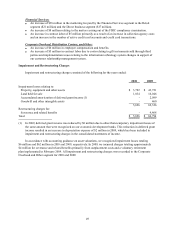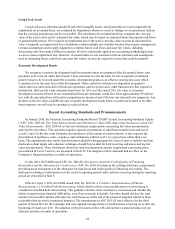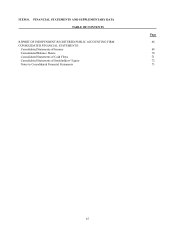Cabela's 2011 Annual Report Download - page 69
Download and view the complete annual report
Please find page 69 of the 2011 Cabela's annual report below. You can navigate through the pages in the report by either clicking on the pages listed below, or by using the keyword search tool below to find specific information within the annual report.59
with a new store or property, some or all of these costs can be recaptured through the repayments of the bonds.
The payments of principal and interest on the bonds are typically tied to sales, property, or lodging taxes generated
from the store and, in some cases, from businesses in the surrounding area, over periods which range between 20
and 30 years. Some of our bonds may be repurchased for par value by the governmental entity prior to the maturity
date of the bonds. However, the governmental entity from which we purchase the bonds is not otherwise liable for
repayment of principal and interest on the bonds to the extent that the associated taxes are insufficient to pay the
bonds. If sufficient tax revenue is not generated by the subject properties, we will not receive scheduled payments and
will be unable to realize the full value of the bonds carried on our consolidated balance sheet. At December 31, 2011,
and January 1, 2011, economic development bonds totaled $87 million and $104 million, respectively.
Grants – We generally have received grant funding in exchange for commitments made by us to the state or
local government providing the funding. The commitments, such as assurance of agreed employment and wage
levels at our retail stores or that the retail store will remain open, typically phase out over approximately five to
ten years. If we fail to maintain the commitments during the applicable period, the funds we received may have
to be repaid or other adverse consequences may arise, which could affect our cash flows and profitability. At
December 31, 2011, and January 1, 2011, the total amount of grant funding subject to specific contractual remedies
was $10 million and $13 million, respectively.
Securitization of Credit Card Loans
Our Financial Services business historically has funded most of its growth in credit card loans through an
asset securitization program. WFB utilizes the Trust for the purpose of routinely selling and securitizing credit card
loans and issuing beneficial interest to investors. The Trust issues variable funding facilities and long-term notes
each of which has an undivided interest in the assets of the Trust. WFB must retain a minimum 20 day average of
5% of the loans in the securitization trust which ranks pari passu with the investors’ interests in the securitization
trusts. In addition, WFB owns notes issued by the Trust from some of the securitizations, which in some cases may
be subordinated to other notes issued. WFB’s retained interests are eliminated upon consolidation of the Trust. The
consolidated assets of the Trust are subject to credit, payment, and interest rate risks on the transferred credit card
loans. The credit card loans of the Trust are restricted for the repayment of the secured borrowings of the Trust.
To protect investors, the securitization structures include certain features that could result in earlier-than-
expected repayment of the securities, which could cause WFB to sustain a loss of one or more of its retained
interests and could prompt the need for WFB to seek alternative sources of funding. The primary investor
protection feature relates to the availability and adequacy of cash flows in the securitized pool of loans to meet
contractual requirements, the insufficiency of which triggers early repayment of the securities. WFB refers to
this as the “early amortization” feature. Investors are allocated cash flows derived from activities related to the
accounts comprising the securitized pool of loans, the amounts of which reflect finance charges collected, certain
fee assessments collected, allocations of interchange, and recoveries on charged off accounts. These cash flows are
considered to be restricted under the governing documents to pay interest to investors, servicing fees, and to absorb
the investor’s share of charge-offs occurring within the securitized pool of loans. Any cash flows remaining in
excess of these requirements are reported to investors as excess spread. An excess spread of less than zero percent
for a contractually specified period, generally a three-month average, would trigger an early amortization event.
Such an event could result in WFB incurring losses related to its retained interests. In addition, if WFB’s retained
interest in the loans falls below the 5% minimum 20 day average and WFB fails to add new accounts to the
securitized pool of loans, an early amortization event would be triggered. The investors have no recourse to WFB’s
other assets for failure of debtors to pay other than for breaches of certain customary representations, warranties,
and covenants. These representations, warranties, covenants, and the related indemnities do not protect the Trust or
third party investors against credit-related losses on the loans.
Another feature, which is applicable to the notes issued from the Trust, is one in which excess cash flows
generated by the transferred loans are held at the Trust for the benefit of the investors. This cash reserve account
funding is triggered when the three-month average excess spread rate of the Trust decreases to below 4.50% or
5.50% (depending on the series) with increasing funding requirements as excess spread levels decline below preset
levels or as contractually required by the governing documents. Similar to early amortization, this feature also is
























